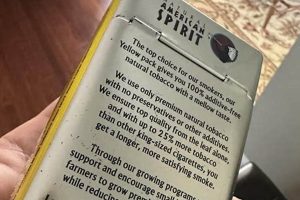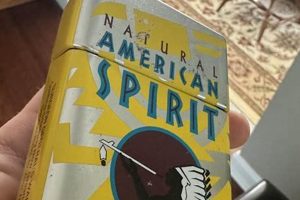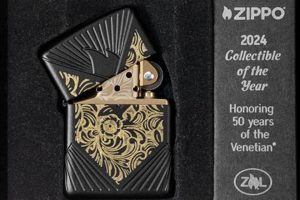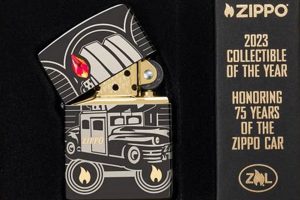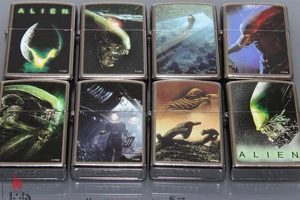A pocket lighter bearing the Boy Scouts of America’s emblem, often featuring specific troop numbers, jamboree commemorations, or rank insignia, falls into a distinct category of memorabilia. These items can range from standard production models with added emblems to limited edition releases specifically designed for Scouting events. An example includes a lighter commemorating the 1981 National Jamboree held at Fort A.P. Hill, Virginia.
These lighters offer a tangible link to Scouting history, preserving memories of specific events and individual achievements. They serve as valuable historical artifacts, reflecting the evolution of the organization’s visual identity and offering insights into past activities. Furthermore, their collectibility contributes to a sense of community among Scouting enthusiasts, providing a common ground for sharing stories and experiences. The rarity of certain models can also contribute to their value.
The following sections delve deeper into specific aspects of these sought-after items, exploring their variations, historical significance, and the burgeoning market surrounding them. Topics covered will include identifying authentic pieces, understanding their value, and resources for collectors.
Collecting Tips
Acquiring and preserving Scouting-related pocket lighters requires careful consideration. The following tips offer guidance for both novice and seasoned collectors.
Tip 1: Authentication is Key: Scrutinize markings and construction. Compare potential acquisitions with known authentic examples. Replicas and unauthorized reproductions exist; vigilance is crucial.
Tip 2: Condition Matters: A lighter’s condition significantly impacts its value. Mint condition examples, especially those with original packaging, command higher prices. Assess for scratches, dents, and functionality.
Tip 3: Research Rarity: Limited edition releases and commemoratives from specific events are generally more valuable. Research production numbers and historical context to understand potential worth.
Tip 4: Understand Variations: Be aware of different case finishes, insert types, and emblem variations. These nuances can significantly affect a lighter’s desirability and value.
Tip 5: Proper Storage is Essential: Protect lighters from humidity, extreme temperatures, and direct sunlight. Specialized storage cases can help preserve their condition.
Tip 6: Network with Other Collectors: Joining collector groups and online forums offers opportunities to share knowledge, learn about new acquisitions, and potentially buy, sell, or trade.
Tip 7: Consult Price Guides and Experts: Utilize reputable price guides and consult with experienced collectors or appraisers to determine fair market values.
By adhering to these guidelines, collectors can build valuable collections while preserving a piece of Scouting history. Careful research and attention to detail are crucial for success in this specialized field.
The insights provided throughout this article aim to equip collectors with the knowledge necessary to navigate the world of Scouting memorabilia.
1. Historical Significance
The historical significance of a Boy Scout collectible Zippo lighter stems from its connection to specific events, periods, and traditions within the Scouting movement. These lighters serve as tangible artifacts, offering insights into the organization’s evolution and the experiences of its members. A lighter commemorating a specific National Jamboree, for instance, encapsulates the spirit of that event, reflecting the participating troops, the activities undertaken, and the broader social context of the time. Similarly, a lighter bearing a specific troop’s insignia provides a glimpse into that troop’s history and its members’ contributions. The presence of specific rank insignia on a lighter can illuminate the achievements of individual Scouts and the values emphasized within the organization.
The historical value of these lighters is further enhanced by their ability to illustrate changes in design aesthetics, manufacturing techniques, and the organization’s visual identity over time. Early examples may feature different construction methods or logo variations compared to later models, offering clues about production processes and the evolution of Scouting symbolism. Examining these changes provides a tangible connection to the past, allowing collectors and historians to trace the development of both the organization and the lighter itself. For example, the use of celluloid inlays versus enamel paint can pinpoint a lighter’s production era, reflecting broader trends in manufacturing and material availability.
Understanding the historical context of these collectible lighters adds a layer of depth and meaning to their appreciation. It transforms them from mere trinkets into valuable historical artifacts, offering insights into the Boy Scouts of America’s enduring legacy. Recognizing the connection between specific designs and historical events enhances their collectibility and underscores their importance as tangible pieces of Scouting history. This understanding allows collectors to appreciate the lighters not just for their aesthetic appeal but also for their contribution to preserving the organization’s rich heritage.
2. Rarity and Value
The value of a Boy Scout collectible Zippo lighter is intrinsically linked to its rarity. Scarcity drives demand within the collector market, influencing pricing and desirability. Understanding the factors contributing to rarity is crucial for assessing a lighter’s potential worth and making informed collecting decisions.
- Limited Production Runs:
Lighters produced for specific events, such as National Jamborees or significant anniversaries, often involve limited production runs. The finite number of these commemorative lighters increases their rarity and, consequently, their value. A lighter produced for a National Jamboree with low attendance, for example, would be inherently rarer than one from a highly attended event. This scarcity contributes significantly to its desirability among collectors.
- Special Editions and Variations:
Variations within standard production models, such as unique case finishes, engravings, or inlays, can also contribute to rarity. A lighter featuring a rare enamel color or a specific troop’s insignia, even if not part of a limited edition, becomes more desirable due to its unique characteristics. For example, a standard production lighter with a factory error in the emblem placement becomes a unique collectible, potentially increasing its value beyond the standard model.
- Condition:
A lighter’s condition significantly impacts its rarity and value. Mint condition examples, particularly those with original packaging and inserts, are inherently rarer than those showing signs of wear. Preserving a lighter’s pristine condition, including its functionality and finish, contributes significantly to its collectibility and market value. An unused lighter from a specific event, preserved in its original box, commands a premium compared to a used example of the same edition.
- Historical Significance:
Lighters associated with historically significant events or figures within the Scouting movement often hold greater value. A lighter owned by a prominent national leader or commemorating a pivotal moment in Scouting history gains rarity and value due to its association. This connection adds a layer of historical significance beyond the lighter itself, making it a more desirable collectible.
These interwoven factors contribute to the overall value and desirability of a Boy Scout collectible Zippo lighter. Recognizing the interplay between limited production, unique variations, condition, and historical context allows collectors to make informed decisions and appreciate the nuances that drive the market for these unique pieces of Scouting history.
3. Design Variations
Design variations in Boy Scout collectible Zippo lighters contribute significantly to their collectibility and historical relevance. These variations reflect different eras, events, and individual expressions within the Scouting movement. Examining these design nuances offers insights into the evolution of Scouting symbolism and the diverse range of commemorations and personalizations available.
- Case Finishes:
The case finish constitutes a fundamental design element. Standard chrome, brushed chrome, high-polish brass, and sterling silver represent common options. Less common finishes, such as gold plating or unique painted designs, increase a lighter’s rarity and value. A brushed chrome finish, for example, might signify a specific production period or commemorative edition, differentiating it from the standard polished chrome. Special editions might feature unique coloration or artwork related to a particular Jamboree or anniversary.
- Emblems and Insignia:
The presence and style of emblems and insignia play a crucial role in a lighter’s design and historical context. Variations include the classic Universal Emblem, specific troop numbers, rank insignia, and event logos. A lighter featuring the Order of the Arrow emblem, for instance, signifies a connection to that specific honor society within Scouting. Similarly, a lighter displaying a World Jamboree logo commemorates that international event and potentially its host country.
- Engravings and Personalizations:
Engravings add a personal touch, often commemorating individual achievements or membership in specific troops. Initials, dates of service, and special awards represent common engravings. A lighter engraved with a Scout’s name and the year they achieved Eagle Scout rank, for example, becomes a personalized memento of their accomplishment. These personalizations add another layer of historical context and sentimental value.
- Inserts and Mechanisms:
While less visually prominent, variations in the lighter’s insert and internal mechanism can also be significant. Different insert dates and markings can help determine the lighter’s production period and authenticity. Specialized inserts, such as those designed for pipe smoking, can add to a lighter’s value and appeal to specific collector niches. Furthermore, the presence of a date code on the insert helps verify the lighter’s age and aligns it with specific design trends of that period.
Understanding these design variations allows collectors to appreciate the diverse range of Boy Scout collectible Zippo lighters available. These variations provide a tangible link to Scouting history, reflecting the evolution of the organization’s visual identity and the personal stories embedded within these collectible items. Recognizing the nuances in case finishes, emblems, engravings, and internal mechanisms enriches the collecting experience and provides a framework for evaluating rarity and historical significance.
4. Authenticity Verification
Authenticity verification is paramount in the realm of Boy Scout collectible Zippo lighters. Counterfeit and reproduction lighters exist, posing a challenge to collectors seeking genuine pieces of Scouting history. Establishing a lighter’s authenticity protects collectors from fraudulent purchases and ensures the preservation of legitimate historical artifacts.
- Bottom Stamps and Date Codes:
Genuine Zippo lighters feature bottom stamps indicating the manufacturer and date of production. These stamps evolve over time, providing a crucial tool for authentication. A lighter purportedly from the 1950s should bear a bottom stamp consistent with that era. Discrepancies between the stamp and the supposed production date raise red flags. Collectors should consult reputable resources documenting Zippo bottom stamp variations to verify authenticity. Variations exist even within specific years, requiring meticulous comparison and cross-referencing.
- Emblem and Insignia Examination:
Close examination of the Boy Scout emblems and insignia is essential. Authentic emblems typically exhibit precise detailing and consistent quality. Counterfeit lighters often display poorly executed emblems with blurry details or incorrect proportions. Comparing the emblem with known authentic examples from the same period is critical. Variations exist in emblem styles over time, necessitating careful consideration of the lighter’s purported production date and the corresponding emblem design used during that era.
- Case Construction and Materials:
The construction and materials of the lighter case offer further clues to authenticity. Genuine Zippo lighters utilize specific materials and construction techniques. Variations in case thickness, hinge design, and metal composition can indicate a non-genuine lighter. For example, a lighter claiming to be solid brass but exhibiting a lightweight feel might be a counterfeit. Careful scrutiny of these physical characteristics is crucial for discerning authentic pieces from reproductions.
- Provenance and Documentation:
Documented provenance, such as original packaging, sales receipts, or historical records linking the lighter to a specific Scout or event, significantly strengthens its authenticity. A lighter accompanied by a photograph of its original owner using it at a Jamboree, for instance, adds substantial weight to its provenance. While not always available, documented history provides valuable evidence supporting a lighter’s authenticity and enhances its historical significance.
These verification methods, used in conjunction, provide a comprehensive approach to authenticating Boy Scout collectible Zippo lighters. Collectors should exercise caution, conduct thorough research, and consult with experienced collectors or appraisers when necessary. Establishing authenticity protects the integrity of the collecting community and ensures that these tangible pieces of Scouting history remain genuine representations of the organization’s legacy.
5. Proper Storage Methods
Proper storage is essential for preserving the condition and value of Boy Scout collectible Zippo lighters. These lighters, often representing significant historical events or personal achievements, require specific care to protect them from environmental factors that can cause damage over time. Neglecting proper storage can lead to diminished value and the irreversible loss of historical integrity. For example, exposure to humidity can cause brass cases to tarnish or develop verdigris, while fluctuating temperatures can damage delicate enamel inlays. Similarly, direct sunlight can fade painted designs and cause discoloration of celluloid components. A lighter stored loose in a drawer alongside other metal objects is susceptible to scratches and dents, impacting its aesthetic appeal and diminishing its value.
Several strategies contribute to effective long-term preservation. Storing lighters in a cool, dry environment away from direct sunlight is crucial. Specialized storage cases, often lined with protective felt or foam, offer additional protection against scratches and impacts. Using silica gel packets within storage cases helps absorb excess moisture, mitigating the risk of tarnish and corrosion. For particularly valuable or historically significant lighters, archival-quality storage materials are recommended. These materials, specifically designed for long-term preservation, minimize chemical interactions that could degrade the lighter’s components. For instance, acid-free archival boxes and tissue paper prevent chemical reactions that could damage finishes or emblems over time.
Implementing proper storage practices safeguards these tangible pieces of Scouting history, ensuring their preservation for future generations. Careful consideration of environmental factors and the use of appropriate storage materials contribute significantly to maintaining a lighter’s condition, preserving its historical significance, and maximizing its value within the collector market. Failure to implement these practices can lead to irreversible damage, diminishing the historical value and financial investment represented by these collectible items. Therefore, proper storage serves as a crucial component of responsible collecting, ensuring the longevity and historical integrity of Boy Scout collectible Zippo lighters.
6. Community and Connection
Boy Scout collectible Zippo lighters serve as more than individual objects; they act as catalysts for community and connection among collectors, enthusiasts, and former Scouts. These lighters ignite conversations, spark shared memories, and foster a sense of belonging within a broader community united by a common interest in Scouting history and memorabilia. The act of collecting, trading, and discussing these items creates a tangible link between individuals, fostering relationships and strengthening bonds within the Scouting fraternity.
- Shared Passion and Identity:
Collecting these lighters provides a common ground for individuals who share a passion for Scouting history and memorabilia. Collectors connect through online forums, dedicated groups, and trading events, creating a community where knowledge and enthusiasm are shared. These interactions reinforce a sense of shared identity, connecting individuals through their mutual appreciation for Scouting heritage. A collector discovering a rare Jamboree lighter, for example, might share their find within an online forum, sparking discussions about the event, its historical significance, and the lighter’s unique design features.
- Intergenerational Connections:
These collectible lighters can bridge generations, connecting former Scouts with current members and fostering a sense of continuity within the organization. A grandfather sharing his vintage Scout lighter with his grandson, for example, transmits not only a physical object but also stories, traditions, and values associated with Scouting. These intergenerational exchanges strengthen family bonds and contribute to the preservation of Scouting heritage within families and communities.
- Storytelling and Remembrance:
Each lighter carries a potential story, whether related to a specific event, a troop’s history, or an individual Scout’s achievements. Sharing these stories within the collector community adds depth and meaning to the items themselves. A lighter commemorating a particular troop’s 50th anniversary, for example, might prompt a former member to share anecdotes about their time in the troop, creating a living history that connects the past with the present. These shared narratives enrich the collecting experience and contribute to a collective understanding of Scouting’s impact on individuals and communities.
- Preservation of Scouting History:
The act of collecting and preserving these lighters contributes to the broader effort of preserving Scouting history. Collectors become custodians of these tangible artifacts, ensuring their survival and safeguarding the stories they represent. This collective effort ensures that future generations can access and appreciate the rich history of Scouting, connecting with the organization’s past through these preserved objects. A collector meticulously documenting the history of a specific lighter, for example, contributes to the preservation of Scouting heritage by creating a record of the lighter’s significance and its connection to the broader history of the organization.
The community and connection fostered by Boy Scout collectible Zippo lighters extend beyond the mere acquisition of objects. These lighters ignite a shared passion, bridge generations, preserve stories, and contribute to the ongoing narrative of Scouting history. They serve as tangible reminders of the values, experiences, and traditions that unite Scouts and collectors alike, creating a vibrant community bound by a common appreciation for the organization’s enduring legacy.
Frequently Asked Questions
This section addresses common inquiries regarding Boy Scout collectible Zippo lighters, providing concise and informative responses to facilitate a deeper understanding of these unique items.
Question 1: How can one differentiate between an authentic Boy Scout Zippo and a counterfeit?
Several key factors aid in authentication: examining bottom stamps for date code consistency, scrutinizing emblem details for accuracy, assessing case construction and material quality, and researching documented provenance when available. Reputable price guides and expert consultation can provide additional support.
Question 2: What factors influence the value of a Boy Scout Zippo lighter?
Rarity, condition, historical significance, and design variations contribute significantly to a lighter’s value. Limited production runs, special editions, pristine condition, and association with significant events or figures increase desirability and market value.
Question 3: Where can one acquire Boy Scout Zippo lighters for a collection?
Potential acquisition sources include online marketplaces, antique shops, specialized dealers, collector forums, and estate sales. Thorough research and careful authentication are crucial before making a purchase.
Question 4: Are all Boy Scout Zippo lighters considered valuable?
Value varies significantly depending on the factors mentioned previously. While all examples possess historical relevance, rarity and condition significantly influence market prices. Common models may hold sentimental value but less monetary worth than scarce variations.
Question 5: How should Boy Scout Zippo lighters be stored to prevent damage?
Optimal storage involves a cool, dry environment away from direct sunlight. Specialized storage cases with protective linings and silica gel packets further mitigate risks of tarnish, corrosion, and physical damage. Archival-quality materials offer the highest level of protection for valuable examples. Avoid storing lighters loose in drawers or exposed to fluctuating temperatures and humidity.
Question 6: What resources are available for researching and learning more about these collectible lighters?
Dedicated collector guides, online forums, and reputable dealers offer valuable information. Connecting with experienced collectors provides opportunities to share knowledge and insights. Museum collections and historical archives may also hold relevant information regarding specific events or periods within Scouting history.
Careful consideration of these frequently asked questions empowers collectors to make informed decisions, authenticate their acquisitions, and preserve these tangible pieces of Scouting history. Thorough research, attention to detail, and engagement with the collector community contribute to a rewarding collecting experience.
For further exploration, the following resources provide in-depth information regarding specific aspects of Boy Scout collectible Zippo lighters
Boy Scout Collectible Zippo Lighters
This exploration of Boy Scout collectible Zippo lighters has illuminated their multifaceted nature. From historical significance and rarity to design variations and authentication challenges, these pocket-sized artifacts offer a tangible connection to Scouting’s rich heritage. Proper storage safeguards their condition, ensuring the preservation of these miniature historical markers. The community fostered by collecting, trading, and discussing these items strengthens bonds among enthusiasts, bridging generations and perpetuating the legacy of Scouting.
These seemingly small objects hold substantial historical weight, reflecting broader social trends and individual experiences within the Scouting movement. Continued research and careful preservation ensure these artifacts remain accessible to future generations, fostering an appreciation for Scouting’s enduring impact. Their stories, etched in metal and flame, illuminate the values and traditions that define Scouting’s legacy.



